 Afterwards we took the children to a community pool featuring a monstrous water slide and a mighty wave machine.
Afterwards we took the children to a community pool featuring a monstrous water slide and a mighty wave machine.
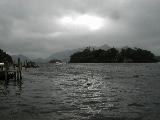
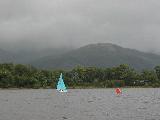 Today in the Lake District it has been too rainy for "fellwalking," which is the local term for hillwalking (since "fell" is the local term for the loftier hills). Instead, we cruised the perimeter of the local lake, Derwentwater, in a launch with a roof over part of it, and we looked at the fells from beneath.
Today in the Lake District it has been too rainy for "fellwalking," which is the local term for hillwalking (since "fell" is the local term for the loftier hills). Instead, we cruised the perimeter of the local lake, Derwentwater, in a launch with a roof over part of it, and we looked at the fells from beneath.
 Afterwards we took the children to a community pool featuring a monstrous water slide and a mighty wave machine.
Afterwards we took the children to a community pool featuring a monstrous water slide and a mighty wave machine.
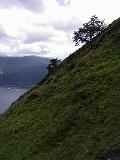
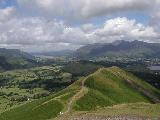
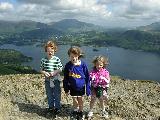 Today the weather was much better. After checking out of our B&B but before leaving the Keswick area, we scaled one of the lesser fells, Catbells (1480 feet), beside Derwentwater. It's the high point visible to the right of center in the top left photo on this page. Photos on right show the children at the summit (with Blencathra or Saddleback, 2850 feet, above Larissa's head); and a look back from the summit at the ridge path we took to get there (with Skiddaw, 3050 feet, in the background right center).
Today the weather was much better. After checking out of our B&B but before leaving the Keswick area, we scaled one of the lesser fells, Catbells (1480 feet), beside Derwentwater. It's the high point visible to the right of center in the top left photo on this page. Photos on right show the children at the summit (with Blencathra or Saddleback, 2850 feet, above Larissa's head); and a look back from the summit at the ridge path we took to get there (with Skiddaw, 3050 feet, in the background right center).
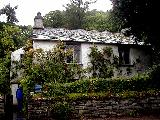 It rained this morning as predicted, and we went to the "attraction" in Bowness devoted to "The World of Beatrix Potter," whose "Peter Rabbit Books" reflect this region, where she lived while writing most of them. Bowness-on-Windermere is the immediately adjoining town to the south of Windermere, and unlike Windermere itself (which shows admirable restraint in this particular), Bowness actually fronts on Lake Windermere. The Beatrix Potter attraction was somewhat of a canned experience, not long on authentic or unique memorabilia, but filled with models and dioramas illustrating her best-known works (except The Tailor of Gloucester for some reason). Many of the dioramas, perhaps even most of them, were set at a level where they were more likely to catch the eyes of children than those of adults, which was a nice touch. After that, as it was still raining, we went to Dove Cottage (left), where Wordsworth had dwelt, and the adjoining Wordsworth Museum. The museum was about as well done as might be, but literature makes a relatively poor subject for museum display. Books transport worldwide with ease and without much if any loss; what is uniquely valuable in the Lake District, both for the understanding of Wordsworth and in general, is rather to be experienced outdoors than in any museum.
It rained this morning as predicted, and we went to the "attraction" in Bowness devoted to "The World of Beatrix Potter," whose "Peter Rabbit Books" reflect this region, where she lived while writing most of them. Bowness-on-Windermere is the immediately adjoining town to the south of Windermere, and unlike Windermere itself (which shows admirable restraint in this particular), Bowness actually fronts on Lake Windermere. The Beatrix Potter attraction was somewhat of a canned experience, not long on authentic or unique memorabilia, but filled with models and dioramas illustrating her best-known works (except The Tailor of Gloucester for some reason). Many of the dioramas, perhaps even most of them, were set at a level where they were more likely to catch the eyes of children than those of adults, which was a nice touch. After that, as it was still raining, we went to Dove Cottage (left), where Wordsworth had dwelt, and the adjoining Wordsworth Museum. The museum was about as well done as might be, but literature makes a relatively poor subject for museum display. Books transport worldwide with ease and without much if any loss; what is uniquely valuable in the Lake District, both for the understanding of Wordsworth and in general, is rather to be experienced outdoors than in any museum.
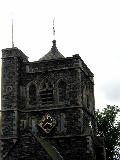
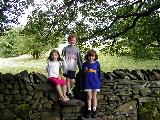
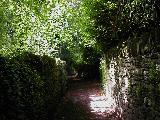 Fortunately, when we emerged from tea at "The Hobbit" afterwards (which establishment disappointingly featured bubkes in the way of Tolkieniana, and played American pop music to boot), the weather had greatly improved and we went for a walk. We passed the church tower shown at left, and proceeded along the walled footpath shown near right, down to the lakefront where we found the stile shown at far right. All three nicely exemplify the masonry-work in slate that we have found so characteristic of the Lake District, with seemingly more than half the houses and all of the fences made thus.
Fortunately, when we emerged from tea at "The Hobbit" afterwards (which establishment disappointingly featured bubkes in the way of Tolkieniana, and played American pop music to boot), the weather had greatly improved and we went for a walk. We passed the church tower shown at left, and proceeded along the walled footpath shown near right, down to the lakefront where we found the stile shown at far right. All three nicely exemplify the masonry-work in slate that we have found so characteristic of the Lake District, with seemingly more than half the houses and all of the fences made thus.
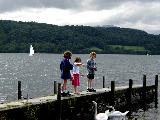 At the lake the children fed the local waterfowl with scraps of bread and toast. Jim Lloyd, the proprietor of this B&B, had provided these from his plentiful supply of such leftovers, and had suggested that we avail ourselves thus. Not least among the charms of this place is that he seems genuinely to like and understand children.
At the lake the children fed the local waterfowl with scraps of bread and toast. Jim Lloyd, the proprietor of this B&B, had provided these from his plentiful supply of such leftovers, and had suggested that we avail ourselves thus. Not least among the charms of this place is that he seems genuinely to like and understand children.